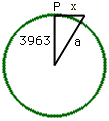It is, indeed, a very simple derivation.
For simplicity, let's assume that the round Earth is a sphere of r=3963mi. This will introduce a very minor error to our result, but given that your argument concerns the order of magnitude of the answer, this should be negligible. Let us also assume that we're measuring 1 mile ahead of us in a straight line, along the tangent of the Earth's curve, rather than 1 mile along its surface. This, again, is purely for simplicity's sake, and won't affect the result significantly.
With these assumptions, we can simplify this problem to a right-angle triangle:

With the starting location being P and x=1mi, we are now searching for the value of a. The difference between a and 3963mi will be the perceived drop.
Employing the Pythagorean theorem, we know that

. Substituting 1 for x we get

, or

. This finally gives us

. Taking the square root of this (and ignoring the negative root), we get

.

.

, or 8 inches rounding up.
What particularly surprises me about your question is that all this information (and more precise derivations which do not rely on simplifying the problem) are abundantly available on the Internet and are well accepted by Round Earthers. A quick Google search to the effect of "how much does the earth drop in a mile" would have been a sensible approach to finding this out.